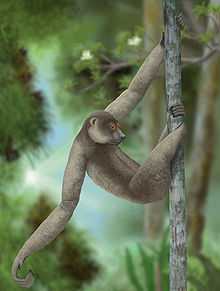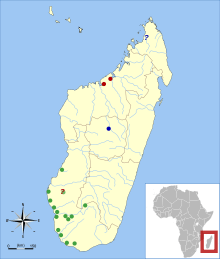Palaeopropithecus
| Palaeopropithecus | |
|---|---|
 | |
| Life restoration of Palaeopropithecus ingens | |
| Scientific classification | |
| Kingdom: | Animalia |
| Phylum: | Chordata |
| Class: | Mammalia |
| Order: | Primates |
| Suborder: | Strepsirrhini |
| Family: | †Palaeopropithecidae |
| Genus: | †Palaeopropithecus G. Grandider, 1899 |
| Species | |
| |
 | |
| Subfossil sites for Palaeopropithecus[2] red = P. kelyus; green = P. ingens; blue = P. maximus | |
Palaeopropithecus was one of three recently extinct genera of sloth lemur that was found on Madagascar, and were closely related to living lemur species found there today. There were three known species, Palaeopropithecus ingens, P. maximus, and P. kelyus. New radiocarbon dates indicate that these large sloth lemurs may have still been living around 1500 CE. It is thought that Palaeopropithecus ingens is mentioned in Malagasy legends as the tretretretre or tratratratra.
Locomotion
Palaeopropithecus was long believed to be an aquatic creature, swimming with its eyes, ears and nostrils just above the water. However, this theory was based on misattributed postcranial remains. Charles Lamberton thoroughly refuted this in 1957. Fossils previously assigned to crania of other species were then reassigned to Palaeopropithecus. Postcranial evidence suggests a highly arboreal lifestyle with suspension locomotion, hence the name sloth lemur.[3]
Anatomy
Palaeopropithecus primarily lived in the trees to stay away from predators as well as to gain valuable resources in food and shelter. To survive properly in the trees, Palaeopropithecus had long and powerful arms and legs. These were used to swing from branch to branch to travel across the jungle. These long arms made it much easier to grab a hold of various trees and branches, making travel at the arboreal level easier. Laurie Godrey stated in The Extinct Sloth Lemurs of Madagascar, "Thus, these animals exhibit the odd behavioral combination of being both specialized leapers and adept climbers and hangers." [3] The long arms of Palaeopropithecus had hook like extremities on their hands and feet. This benefited Palaeopropithecus by enabling them to hook their bodies onto the foliage to stabilize themselves as they traversed through the trees. Palaeopropithecus weighed an average of about thirty-five kilograms or around 77 pounds. This weight is heavier than most modern lemurs and could potentially have caused the species to fall while hanging on branches, forcing the species to make sufficient use of their long arms and legs to survive.[4] Palaeopropithecus eating habits were different then modern lemurs. Their teeth were tougher so they can eat hard foods such as nuts and seeds. This helped them fill out a generalized niche were they can have multiple food resources to rely on.
The anatomy of their bones were generally curved with a sixty-degree bend on major bones in the legs and arms. These bones were much denser than normal and with the edition of the curved structure of the bones it allowed Palaeopropithecus an easier capability to swing from branch to branch. William Junger wrote, “curvature indicates that the sloth lemurs are one of the most suspensory clades of mammals ever to evolve.[5] The curved bones also helped them gain more torque and speed allowing them to reach branches at great distances. This was because they had more muscle to hold onto various branches and trees. The relatively small body of Palaeopropithecus, while large compared to the modern lemur, had a great degree curve because it was smaller in stature. There is an inverse relationship between the bigger the animal and the smaller the bone degree curve.
Diet
The Palaeopropithecus species were probably folivorous based on dental morphology,[6] consuming a mixed diet of foliage and fruit to varying degrees.[7] They supplemented their leaf-eating with substantial amounts of seed-predation, much like modern indrids.[8] There is also no molar use wear evidence that Palaeopropithecus relied on terrestrial foods (C4 grasses, tubers, rhizomes).[7]
Palaeopropithecus ingens and P. maximus have similar use-wear scars. These were apparently mixed fruit and foliage consumers and moderate seed predators; neither species appears to have been a hard-object specialist.[7] Palaeopropithecus kelyus had smaller teeth than the other two species, Palaeopropithecus ingens and Palaeopropithecus maximus. Its dental characteristics could be described from the P. kelyus subfossil maxilla fragment, showing a crista obliqua, a parastyle and a highly developed mesostyle. This morphology is reminiscent of the present day Propithecus genus. While other Palaeopropithecus must have fed on leaves and fruit, the differences in the teeth of Palaeopropithecus kelyus suggest that this animal could chew much tougher foods (notably seeds) compared with the other two known species. Evidence is accumulating that they may survive on low quality (that is highly fibrous) staple or fallback foods and a life-history “strategy” of low maternal input and slow returns in an unpredictable and periodically stressful environment.[3] Palaeopropithecus was the most suspensory of all known strepsirhines, and so they would feed in suspensory postures.[6] Locomotion on the ground would have been ungainly, and probably quite rare, except to creep across the ground from one feeding tree to the next when presented with gaps in the forest canopy.
Behavior
Palaeopropithecus has a very active behavior especially because they have the ability to move from branch to branch given by their four limbs. While keeping their head downwards, they are similar to today’s South American sloths.[3] It has also been noted that Palaeopropithecus is partly an aquatic creature because of its cranium which paleontologist Herbert, F. Standing concluded. It was believed that in their behavior, they were able to stand and their cranial structures were able to show these abilities.[3]
Extinction
When Palaeopropithecus went extinct is not exactly clear, however scientists have suggested that it could be as recent as about five hundred years ago (anywhere from 1300 to 1620AD).[9] The reason behind the extinction of the several species of Palaeopropithecus has been attributed to the presence of humans to the island of Madagascar, the earliest evidence of which dates back to 2325±43 yr BP.[9] Scientists have found fossils of Palaeopropithecus that appeared to have cut marks in them, suggesting flesh removal with a sharp object, indicating that the species was hunted by the earliest colonists to the island of Madagascar as a source for food.[10] The first evidence of the early human butchery to Palaeopropithecus was found by Hon. Paul Ayshford Methuen, in 1911, who traveled to Madagascar expressly to collect bones of the extinct lemurs for the Oxford Museum.[3] The slow locomotion habits of Palaeopropithecus likely made them an easy target for their human predators, who would consume them for food, as well as use the bones for tools.[9] The introduction of humans to Madagascar brought change to an island that had yet to experience the lifestyles of human beings. Introduction of man-made charcoal and fire to the island caused considerable damage to the forests where Palaeopropithecus lived and bred.[3] In addition the slow reproductive habits of Palaeopropithecus probably attributed to their swift and sudden extinction.[10]
Miscellaneous
There were three known species of Palaeopropithecus: Palaeopropithecus ingens, Palaeopropithecus maximus, and Palaeopropithecus kelyus. Palaeopropithecus ingens is thought to also be the mythical Malagasy creature known as the Tretretre, or the alternate name of Tratratra.[3] According to new radiocarbon dates, Palaeopropithecus may have still been alive at 1500CE. However, Yale biologists who extracted DNA from the bones and teeth of 9 subfossil individuals from Palaeopropithecus state that all the giant lemurs analyzed died well over 1,000 years ago. Another thing they confirmed was that there is a close relationship between the sloth lemurs and currently living indrids. For example, Palaeopropithecus were born with highly developed teeth, just like indrids.[4]
References
- ↑ Gommery, D.; Ramanivosoa, B.; Tombomiadana-Raveloson, S.; Randrianantenaina, H.; Kerloc’h, P. (2009), "A new species of giant subfossil lemur from the North-West of Madagascar (Palaeopropithecus kelyus, Primates)", Comptes Rendus Palevol 8 (5): 471–480, doi:10.1016/j.crpv.2009.02.001, lay summary (27 May 2009)
- ↑ Godfrey, L.R.; Jungers, W.L. (2002). "Chapter 7: Quaternary fossil lemurs". In Hartwig, W.C. The Primate Fossil Record. Cambridge University Press. pp. 111–112. ISBN 978-0-521-66315-1.
- ↑ 3.0 3.1 3.2 3.3 3.4 3.5 3.6 3.7 Godfrey, Laurie R., William L. Jungers. (2003). "The extinct sloth lemurs of Madagascar". Evolutionary Anthropology 12: 252–263. doi:10.1002/evan.10123.
- ↑ 4.0 4.1 Gommery, Dominique. "New Extinct Lemur Species Discovered in Madagascar." Phys.org. CNRS, France, 26 May 2009. Web. 21 Oct. 2012.<http://phys.org/news162565443.html>.
- ↑ Jungers, William L., Laurie R. Godfrey, Elwyn L. Simons, and Prithijit S. Chatrath. "Phalangeal Curvature and Positional Behavior in Extinct Sloth Lemurs (Primates, Palaeopropithecidae)." Proc. Natl. Acad. Sci. USA. Department of Anatomical Sciences, School of Medicine, State University of New York, Stony Brook, NY, 28 Aug. 1997. Web. 21 Oct. 2012.<http://www.pnas.org/content/94/22/11998.full.pdf>
- ↑ 6.0 6.1 Fleagle, J.G. 1988. Primate Adaptation and Evolution. Academic Press: New York. books.google.com/books?isbn=0122603419
- ↑ 7.0 7.1 7.2 Laurie R. Godfrey, Gina M. Semprebon, William L. Jungers, Michael R. Sutherland, Elwyn L. Simons, Nikos Solounias. Dental use wear in extinct lemurs: evidence of diet and niche differentiation. Journal of Human Evolution, Volume 47, Issue 3, September 2004, Pages 145–169. http://dx.doi.org/10.1016/j.jhevol.2004.06.003
- ↑ K.L. Rafferty, M.F. Teaford, W.L. Jungers. Molar microwear of subfossil lemurs: improving the resolution of dietary inferences. Journal of Human Evolution, Volume 43, Issue 5, November 2002, Pages 645–657. http://dx.doi.org/10.1006/jhev.2002.0592 D.Gommery et al., C.R. Palevol, vol 8 (5), July–August 2009. http://phys.org/news162565443.html
- ↑ 9.0 9.1 9.2 http://www.edgeofexistence.org Sloth lemur or tretretretre (Palaeopropithecus ingens), Baillie, Jonathan (Edge of Existence Team), 10/23/12, http://www.edgeofexistence.org/mammals/species_info.php?id=543
- ↑ 10.0 10.1 Ventura R. Perez, Laurie R. Godfrey, Malgosia Nowak-Kemp, David A. Burney, Jonah Ratsimbazafy, Natalia Vasey, Evidence of early butchery of giant lemurs in Madagascar, Journal of Human Evolution, Volume 49, Issue 6, December 2005, Pages 722-742, ISSN 0047-2484, 10.1016/j.jhevol.2005.08.004.(http://www.sciencedirect.com/science/article/pii/S004724840500148X)